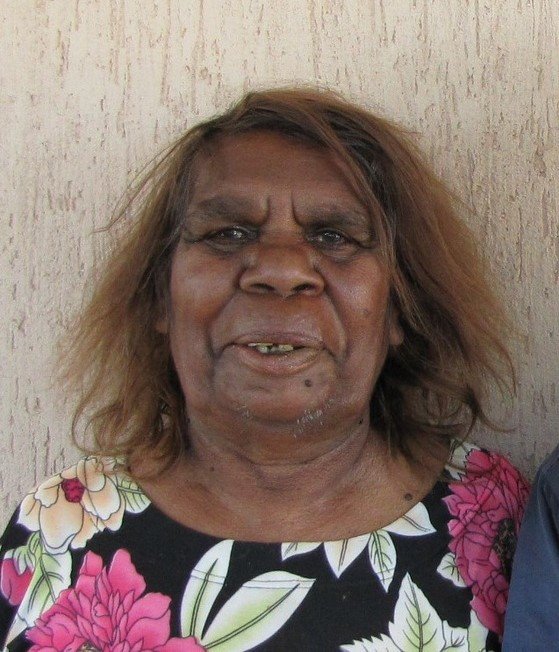LILY KELLY NAPANGARDI
BIOGRAPHY

Photo: Clare Valley Art Gallery
Born at Dashwood Creek in 1948, Lilly Kelly Napangardi arrived at Haasts Bluff as a baby in the arms of her mother Narputta and her father Sandy Opal Tjapanangka. The family moved to the newly established settlement of Papunya in 1958 when Lilly was still a young girl and her father became one of the original Papunya Tula shareholders. In the late 1970’s Lilly married Norman Kelly Tjampitjinpa and began assisting him with his paintings while living at Papunya, before the family moved 75 km west to Mt Liebig at the foot of the McDonnell ranges.
Lilly Kelly began painting in her own right for Papunya Tula Artists during the mid 1980’s when the company's field officers first began visiting Mt. Liebig regularly, and in 1986, she won the Northern Territory Art Award for a painting entitled Watiyawanu. The win drew attention to the growing number of artists in Mount Leibig and the nascent art centre operated by the shop owners in the community.
During the 1990’s Norman Kelly moved to Lajamanu and took a second wife while Lilly remained at Mount Leibig and brought up their three children. In time, while she continued to paint without particular distinction, she became one of the senior Law Women of the community, and the custodian over the Women Dreaming stories associated with Kunajarrayi, in Warlpiri and Luritja country stretching between Mt Liebig, Haasts Bluff, Kintore and Coniston. Recognized as a senior law woman she passed on her knowledge of traditional law and ceremonial dancing and singing to her children, eleven grandchildren, and other young women of her clan.
With the success of the Watiyawarnu art centre, Lilly Kelly’s paintings began once more to gain national attention from 2000 onward through its participation in the annual Desert Mob exhibition in Alice Springs and her own selection as a finalist in the NATSIA Telstra awards. Her depictions of country during this period and thereafter referred to sand hills, the effect of wind and rain on the desert landscape, and the crucial waterholes found in the area. The best of these works evoke the ephemeral nature of the drifting, changing sandy country in the finest microcosmic detail. Rain streaks the land as it runs off the sand hills while the blowing wind folds them into the undulating waves of an infinite expanse. Yet beholding each work in is entirety is to view the landscape in macrocosm as the eye follows the hypnotic fine doting and muted tones that build up into a mysterious, enigmatic topography of her land. Rendered in intricate detail, with subtle colour variations these paintings covey powerful and inspiring visions of her country with an apparent accuracy.
Early examples of Lilly Kelly's sandhill paintings are rendered using a dotting technique, which diminishes the size of the dots with each row, rather than her later works which diminish the dots within each evolving line. Earlier works therefore have a more meditative settled quality and stronger formal compositional structure. In her later works the ebb and flow of the dotting is evocative, rhythmic and ultimately engaging.
Lilly Kelly has been described by those who know her art practice intimately, as an action painter. They suggest that her works are essentially haptic and unplanned and that she engages in painting without any formal schema in mind. If this is the case, then it is likely that it is, in fact, this informality that evokes such a powerful response from the viewer.
The first institutional purchase was of two spectacular major works to the Art Gallery of New South Wales arranged through Neil Murphy Indigenous Art, which organized a solo exhibition for the artist at Span Galleries in Melbourne in the same year. In the wake of her Melbourne success Kelly was reputedly under consideration for inclusion in the 2004 Biennale of Sydney however, although nominally represented by Watiyawanu Artists, she has painted indiscriminately for many dealers in Alice Springs since that time and attempts to present her works at the highest level have, unfortunately failed.
Lilly Kelly is a very fine artist who is capable of greatness and with this no doubt in mind, Australian Art Collector Magazine selected her as one of Australia's 50 most collectable artists for 2006. Yet in equal measure she produces perfunctory works motivated more by income than the pleasure of creative engagement. A number of her finest paintings have been acquired by major international collectors including Thomas Vroom and Richard Kelton as well as being added to several Australian State art galleries. The magnificent paintings held by the Art Gallery of NSW, rated by Murphy as the artist’s finest, were exhibited in the exhibition Gifted: Contemporary Aboriginal Art: The Molly Gowing Acquisition Fund in 2006/2007.
© Adrian Newstead
References
Johnson, Vivien, Lives of the Papunya Tula Artists, IAD Press, Alice Springs, 2008.
McCulloch Childs, Emily and Gibson, Ross, New Beginnings, Classic Paintings from the Corrgan Collection of 21st Century Aboriginal Art, McCulloch and McCulloch Australian Art Books, 2008.
Newstead, Adrian, Lawson Menzies Art Catalogue, November 2006
Carmel Dwyer, Australian Art Collector Magazine, Issue 35, 2006 p 106

